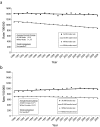Leading causes of death and all-cause mortality in American Indians and Alaska Natives
- PMID: 24754554
- PMCID: PMC4035872
- DOI: 10.2105/AJPH.2013.301798
Leading causes of death and all-cause mortality in American Indians and Alaska Natives
Abstract
Objectives: We present regional patterns and trends in all-cause mortality and leading causes of death in American Indians and Alaska Natives (AI/ANs).
Methods: US National Death Index records were linked with Indian Health Service (IHS) registration records to identify AI/AN deaths misclassified as non-AI/AN. We analyzed temporal trends for 1990 to 2009 and comparisons between non-Hispanic AI/AN and non-Hispanic White persons by geographic region for 1999 to 2009. Results focus on IHS Contract Health Service Delivery Area counties in which less race misclassification occurs.
Results: From 1990 to 2009 AI/AN persons did not experience the significant decreases in all-cause mortality seen for Whites. For 1999 to 2009 the all-cause death rate in CHSDA counties for AI/AN persons was 46% more than that for Whites. Death rates for AI/AN persons varied as much as 50% among regions. Except for heart disease and cancer, subsequent ranking of specific causes of death differed considerably between AI/AN and White persons.
Conclusions: AI/AN populations continue to experience much higher death rates than Whites. Patterns of mortality are strongly influenced by the high incidence of diabetes, smoking prevalence, problem drinking, and social determinants. Much of the observed excess mortality can be addressed through known public health interventions.
Figures

References
-
- Denny CH, Holtzman D, Cobb N. Surveillance for health behaviors of American Indians and Alaska Natives: findings from the Behavioral Risk Factor Surveillance System, 1997–2000. MMWR Surveill Summ. 2003;52:1–13. - PubMed
-
- Indian Health Service. Trends in Indian Health, 2002-2003 Edition. Washington, DC: US Department of Health and Human Services; 2009.
-
- Murphy SL, Xu J, Kochanek KD. Deaths: final data for 2010. Natl Vital Stat Rep. 2013;61(4) - PubMed
-
- Arias E, Schauman WS, Eschbach K, Sorlie PD. The validity of race and Hispanic origin reporting on death certificates in the United States. Vital Health Stat 2. 2008;2(148) - PubMed
MeSH terms
LinkOut - more resources
Full Text Sources
Other Literature Sources

